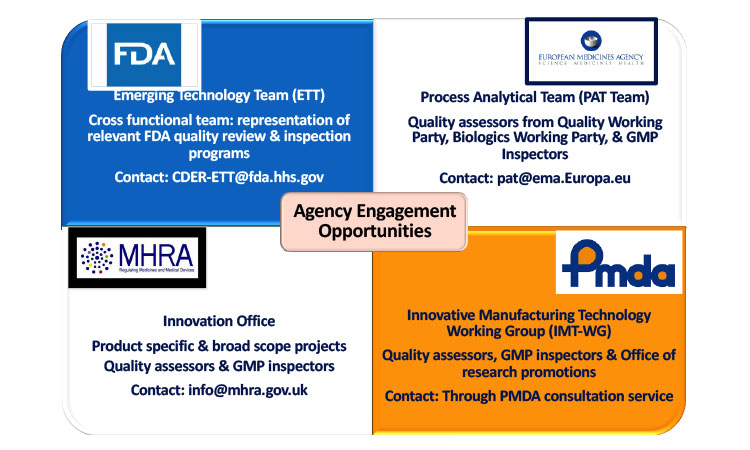Team Approach
To support innovation in manufacturing and the adoption of novel technologies, several regulatory agencies have formed teams to advise sponsors seeking to implement new technologies such as CM. These regulatory teams include the Emerging Technology Team within the US FDA, the Process Analytical Technology Team within the European Medicines Agency, the Innovative Manufacturing Technology Working Group within Japan’s Pharmaceuticals and Medical Devices Agency (PMDA), and the Innovation Office within the United Kingdom’s Medicines and Healthcare Products Regulatory Agency (MHRA) (Figure 1).
These focused groups within each agency encourage companies to engage with agencies early and frequently as they work on new technology initiatives. The goal is to provide an opportunity to discuss novel strategies and approaches prior to the regulatory submission. This dialogue between industry and regulatory agency helps regulators understand the technology and alerts sponsors to potential regulatory concerns. Early engagement with regulators reduces regulatory uncertainty and lowers the number of questions during the review period. Each regulatory agency has a specific pathway to initiate interaction, and the opportunity to leverage these resources may be limited based on their availability and the agency’s priorities at the time.
Although current regulatory guidance does not prevent the use of CM, final guidelines on the topic are not yet available. The lack of regulatory guidelines can hinder technology implementation, regulatory approval, and life-cycle management for CM-manufactured products, especially when those products are intended for international markets.
ICH Q13
To address these concerns, CM was selected as a topic for the recently initiated International Council for Harmonisation of Technical Requirements for Pharmaceuticals for Human Use (ICH) guideline, “ICH Q13: Continuous Manufacturing of Drug Substances and Drug Products”.
The ICH Q13 guideline under development seeks to harmonize CM-related definitions and regulatory concepts, dene key scientific approaches for CM, and clarify regulatory expectations. Some specific aspects of CM that the guideline is expected to address include state of control, system dynamics, material traceability, process models, and advanced process controls. The final document, which will likely be issued around 2021, will provide clarity on how drug manufacturers can use flexible approaches to develop, implement, and integrate CM for new and existing drug substances or drug products.
The ICH guideline process provides a unique opportunity to increase exposure to and knowledge of CM among regulators worldwide. ICH currently includes 10 regulatory agencies representing 37 countries and 13 regulatory observers, and it continues to grow steadily. Worldwide harmonization of regulatory concepts is especially important for CM because high levels of integrated measurements and controls are frequently used in CM processes. Alignment among all regulatory agencies on the different approaches for developing regulatory control strategies for CM is essential for the efficient deployment of these technologies.
As we wait for a finalized ICH guideline on CM, conferences and publications provide useful technical and regulatory information. Recently, conferences and workshops covering CM for both small and large molecules have proliferated; some of these events have been organized by ISPE as stand-alone conferences or as part of other regular conferences such as the ISPE Annual Meeting or the ISPE Facilities of the Future Conference. For additional regulatory insight into current approaches and expectations for CM, readers may refer to several recent publications on CM that are technical and regulatory/quality focused
,
,
,
,
as well as articles summarizing notable CM conferences.,




